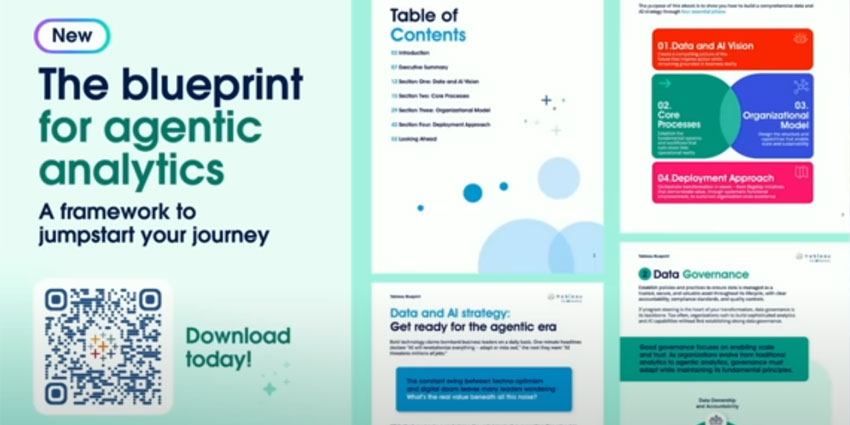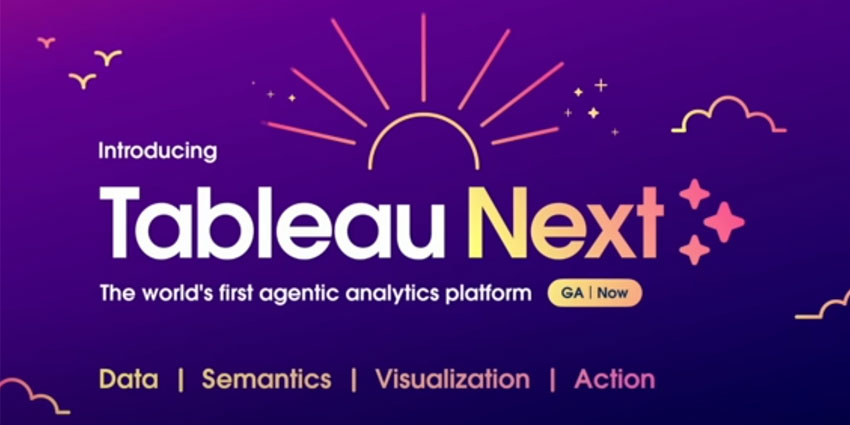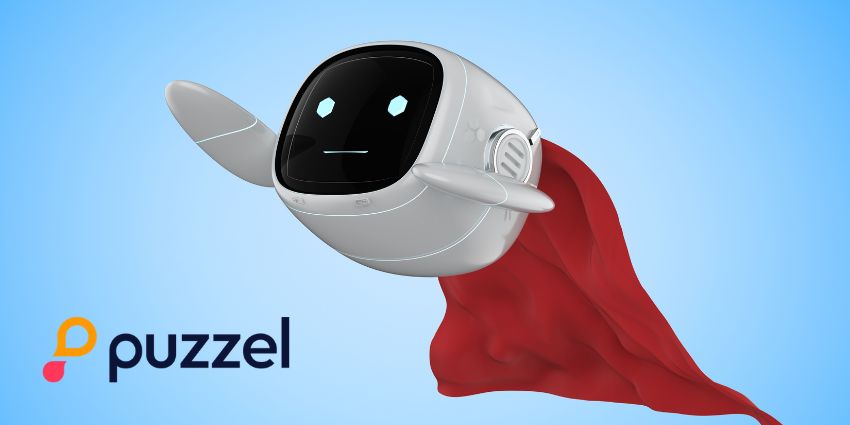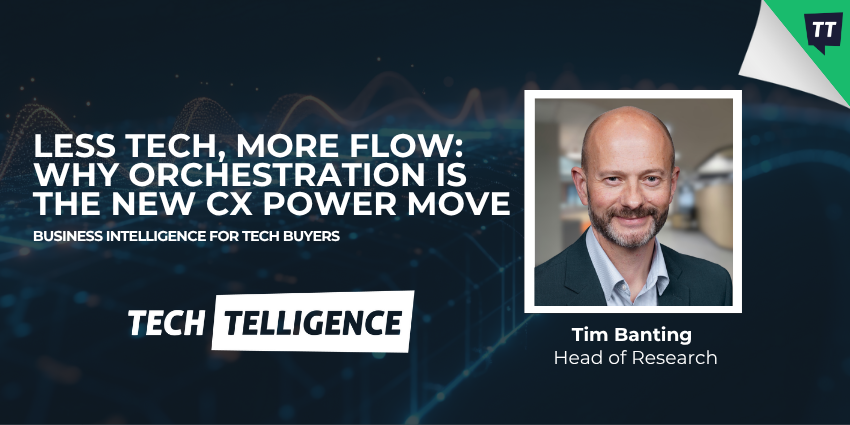Salesforce has debuted Tableau Next, the “world’s first agentic analytics platform”.
Yet, this is no new platform announcement. Instead, it signals a new vision for Tableau.
Shared during last week’s Tableau Conference 2025, this vision frames the solution as a place where users can collaborate with AI agents to accelerate the “entire data-to-action workflow”.
As they do so, users should think of Tableau as comprising four layers: data, semantics, visualization, and action – as evident in the graphic below.

The bottom data layer connects to any source, with businesses pulling data into Tableau – via zero-copy – to provide the foundation.
Then, the semantics layer establishes consistent data definitions and context, enabling a unified understanding of that business data.
“[The semantic layer] means getting the most trusted insights from your data — no matter what organization you’re in, no matter what department you belong to,” said Ryan Aytay, CEO of Tableau, during his keynote.
Then, there is a visualization layer to translate data from the semantic layer into actionable insight for various business users: analysts, decision architects, agent forces, organizational leaders, CXOs, etc.
Users can also store and reuse these visuals via a new marketplace (more on this later!).
Finally, there’s the integrated action layer. “It’s a bit of a tongue-twister, but it’s so important,” said Aytay. “What it means is getting insights wherever you are.
On a plane? On your phone? At your desk? In Tableau. In Slack? In your workflow? Maybe in Workday or Box? It doesn’t matter. Insights should meet you where you work.
AI agents, native to Tableau. will deliver those insights. Meanwhile, brands can also use Agentforce to create agents that leverage insights to kickstart business flows.
However, those native, out-of-the-box agents make for the first big talking point.
1. Tableau’s Concierge & Inspector Agents Steal the Show
The Concierge Agent in Tableau allows employees to interact with their data “in a way that business people speak.”
Indeed, the Agent takes a question, applies context from the semantic layer, and sends it down into the data layer. It then comes up with a response.
However, it’s not just a text-based response; the Concierge Agent can also present visuals.
For Southard Jones, Chief Product Officer at Tableau, that’s key. “We don’t just want to hear the answer; we want to see and understand what’s happening in the data,” he said.
Lastly, on Concierge, there’s also a “Sources” feature. Think of it like a citation in a research paper. It presents the reasoning behind the agent’s actions and where the semantic data came from.
Then, there’s the Inspector Agent. It tracks the data in Tableau continuously, monitoring sudden shifts, spotting trends, and making predictions.
Critically, the Inspector Agent also offers proactive alerts on key data trends, such as a sudden drop in customer satisfaction.
As Jones explained:
I think of Inspector a little bit like an omniscient caretaker working behind the scenes.
Salesforce shared an example of how the Inspector Agent could help track the performance of a campaign while also keeping an eye on budgets.
It could then send alerts to the campaign leader, like: “Hey, you’re exceeding your target and still have $25,000 left. What do you want to do? Do you want to double down?”
Yet, that’s just one of many possible use cases.
Alongside the Concierge and Inspector Agents is a Data Pro Agent. This helps teams clean and change data, offering smart suggestions on how to do it and automating some of the work.
2. Tableau’s New Blueprint, Slack Channel, & Marketplace Catch the Eye
Salesforce has released several support resources to help businesses find success with Tableau Next.
First is Tableau Blueprint, which offers a framework for agentic analytics. It answers the following questions: How do I get started? How can I create a vision for it? How do I build processes around it? How do I design the right organizational structure to support it? And so on.
With this, businesses may define their data and AI strategies, execute, and – according to Salesforce – “cultivate their data strategies”.

Then, there’s a new Slack workspace for the Tableau community. Rekha Srivatsan, Chief Marketing Officer at Tableau, introduced this: “You can create your own channels, keep the discussions going, and stay connected.
Whether you’re a data newbie, a data rockstar, or somewhere in between — it doesn’t matter. You’ve got each other. And together, we’re going to navigate this exciting Agentic AI era.
Finally, there’s the new Tableau Marketplace, which offers a personal gallery for a data analyst’s best practices, reports, and visualizations.
“The Marketplace works for semantic models, data connections, workflows — any of those things,” summarized Srivatsan. “And the best part is, they can all be reused!”
3. Salesforce (Somewhat) Acknowledges Job Displacement
During the keynote, Aytay stressed that innovations like the Concierge and Inspector Agents will augment the business analyst role.
Yet, in doing much of the busy work, Salesforce acknowledged that AI will take – at the very least – part of that position. There was no way around it.
So, while exciting, the innovations may have had many attendees at the Tableau 2025 conference questioning the long-term impact of this technology on their jobs.
As such, Salesforce should consider doing more to tie a bow around that for data analysts so they can tell their bosses: here’s why you still need me.
That’s according to Rebecca Wetteman, CEO & Principal Analyst at Valoir. She told a Tableau Conference 2025 watch party:
An excellent exercise would have been to give attendees an index card to write down three things they can do that AI would never be able to do, so when they’re in the elevator with their boss’s boss, they already have the answer for that.
Such an exercise would help Salesforce explain the additional value human data analysts can add and why that value increases with Tableau Next.
So, while Salesforce will undoubtedly add more AI agents to Tableau, it should also focus on best practices for data analysts to add value as more of their daily tasks become more prone to automation.
4. Pricing AI Agents Remains a Sore Spot
During its keynote, Salesforce didn’t mention pricing for the AI Agents on Tableau.
Still, the CRM leader sells Agentforce agents at a two-dollar consumption rate, but that has “scared a lot of people”, according to Wettemann.
After all, there are so many ways that businesses can apply agents across their operations, with different scales of value.
Keeping tabs on whether Agentforce is delivering ROI with that skew in value – alongside varying consumption levels across the business – will prove problematic.
Indeed, with so much unpredictability in the consumption of Agentforce, it’s often hard to predict, plan, and move beyond pilots. That may limit the adoption of Tableau’s agentic analytics.
As such, Salesforce is likely rethinking its pricing structure.
Thankfully, there are other models to learn from. As Wetteman noted:
The companies that have done the best in turning from per-seat to consumption with AI are folks like Verint. They bit the bullet and said: “We’ve got to go on value, and we’ve got to go on more than just consumption because it’s more complex than that.
Just remember, Salesforce aims – fundamentally – to reshape how people work. Therefore, it also must consider how new work structures fit into the pricing equation. That’s a lot to mull over.
The cherry on top? Salesforce also needs to communicate its strategy effectively to sales teams so they can ease enterprise concerns.
5. Tableau Looks to Find Its Place within the Salesforce Ecosystem
During the Tableau Conference 2025, Salesforce shared several excellent demos.
One showed how a business could model zero-copy data from Databricks, create a semantic model in Tableau, and develop a visual of how much it costs to acquire a new customer.
Such a use case shows the value of Tableau to sales teams invested in the Salesforce ecosystem.
Yet, the CRM leader could have gone further to emphasize how Tableau fits into the overall scheme of Salesforce as the ecosystem’s central data & analytics platform.
So, if a company is on Marketing Cloud or any other Customer 360 app, it understands Tableau’s value as a data visualization interface.
That’s critical as Agentforce remains just a small part of Salesforce’s business.
Chiefly, Salesforce is still a CRM platform provider, and Tableau’s biggest growth opportunity is within that ecosystem.
More News from Salesforce
Alongside Tableau Next, Salesforce launched another new offering last week: Agentforce for Consumer Goods.
Agentforce for Consumer Goods provides new agent skills and components for businesses in the Consumer Goods space.
In releasing the offering, Salesforce strives to get consumer goods companies started on their agentic AI journeys, see value, and build an appetite for delivering more complex, custom agents.







